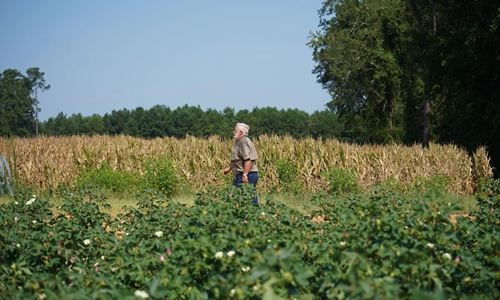HOME >> SOURCE
Struggling to profit from cotton, US farmer counts on trade deal with China
Source:Xinhua Published: 2020/1/4 17:10:49

A cotton boll is pictured at cotton farmer Joe Boddiford's farm in Sylvania, Georgia, the United States, on Aug. 1, 2019. (Xinhua/Liu Jie)
When the news came that China and the United States had agreed on the text of a phase-one deal toward resolving their trade disputes, cotton farmer Joe Boddiford felt greatly relieved.
He called the progress "a step in the right direction."
For the 70-year-old, US farmers have particularly but not exclusively fallen victim to the trade disputes between the two countries.
FLAT PRICES, STAGNANT YIELD
In an earlier interview with Xinhua days before the phase-one deal was announced, Boddiford, standing next to five big silos, said "I'm waiting for the deal," adding it was exactly the reason he was hesitant to sell the fiber he had just harvested.
Cotton prices have been flat this year, said Boddiford, who harvested 900 acres (364 hectares) of cotton this fall on his farm in Sylvania, a city in the state of Georgia.
That is the result of him having shifted about 100 acres (about 40.5 hectares) of cotton to corn when making this year's planting arrangement, because his estimate was for corn to gain higher prices, the farmer said, adding that 1,000 to 2,000 acres (about 405 to 809 hectares) would be "a fairly typical number" of acreage for full-time cotton growers in his area.
Given the uncertainty over US agricultural trade policy, how the trajectory of cotton prices will evolve is hard even for a farmer as seasoned as Boddiford to predict.

Cotton farmer Joe Boddiford is pictured at his farm in Sylvania, Georgia, the United States, on Aug. 1, 2019. (Xinhua/Liu Jie)
Yet, Boddiford, who has farmed for 45 years on his 2,400-acre (971-hectare) farm, is sure about one thing -- it is hard to make a profit with the cotton price at 60-cent per pound.
In the latest World Agricultural Supply and Demand Estimates report published on Dec. 10, the US Department of Agriculture (USDA) projected a total of 13.76 million acres (about 5.6 million hectares) of farmland to be used to plant cotton in the current market year.
Speaking of his planting plan for next year, Boddiford said he only had a "vague idea" -- especially with regard to cotton.
Yield, which directly affects profitability, is a key concern for Boddiford when making decisions. "I think cotton yields have been kind of stagnant for a few years," he added.
The USDA report projected 775 pounds (about 352 kg) of cotton yield per harvested acre nationwide for the current market year, down 10.3 percent from the estimate for the previous season.
Cotton yield is expected to suffer a third consecutive decline in the current market year, data showed.
Boddiford cast doubt on the credibility of the USDA's crop reports, saying the system by which the agency makes the forecasts "is not working right." For him, the prospect is even bleaker.

Cotton farmer Joe Boddiford walks at his farm in Sylvania, Georgia, the United States, on Aug. 1, 2019. (Xinhua/Liu Jie)
TARIFF-RELATED UNCERTAINTY
Boddiford harvested a total of 1,800 bales of 480-pound-per-bale (about 218-kg-per-bale) cotton this year, a decline of 200 bales from the previous year. He has been holding all of the just-harvested fiber in the silos, waiting for prices to go up.
"I won't hold it for more than a year," Boddiford said, adding that even if the prices were to remain unsatisfactory, he "will probably sell it by next harvest," which comes in the fall of 2020.
The USDA predicts 5.5 million bales of ending stocks for cotton for the 2019/20 market year, the highest since the 2008/09 market year, indicating three years of continuous increase in leftover crop.
"That's fundamentally a bearish outcome because you are increasing year over year," said John Robinson, a professor at Texas A&M University's Department of Agricultural Economics who specializes in cotton economics, marketing and policy.
Robinson said similar to farmers' hesitation in selling their cotton, merchants are also adopting a wait-and-see attitude toward shipping the crop to export markets.
He said the additional tariffs imposed since Washington initiated the trade disputes with Beijing had "a significant effect" on US cotton exports to China.
"The tariffs have made (US cotton exporters) hesitant to do a lot of business with China, because they don't know whether export sales that they made will be canceled, and they don't know if the tariffs will get higher," the professor said, adding that there is "just a lot of business-to-business uncertainty."
The share of US cotton in the Chinese market averaged 30 percent in the five-year period prior to the trade spat, but it has dropped dramatically to 18 percent since 2018, Robinson said.
"I think it's mainly because of the tariffs," he said. "As an economist, I think tariffs are a tax on consumers and they probably slowed demand, and that's not good anywhere for anyone."
Robinson said the goal of the World Trade Organization and "all the trade negotiations for the last 20 or 30 years" has been reducing tariffs among all trading partners. "And the more we do that, the better."
The professor added that most farmers in the United States hope the trade conflict will soon come to an end, and he himself hopes so as well.
FRESH HOPE
In light of the latest development, Boddiford said all US farmers now feel more confident about selling more agricultural products to China, adding that farm products grown in the southern region of the United States "for sure need better prices," especially in big export markets like China.
Despite his unwillingness to sell cotton before its prices reach the 80-cent range, Boddiford said he expects the upcoming trade agreement to incentivize more US corn exports to China. "That's not one of the main things that we have had with China," he said.
Boddiford said there is flexibility until April or May of 2020 for him to settle down with the final planting plan. "To be a farmer, you've got to be an eternal optimist."
He said historically, the US cotton export commitments -- which include the sales that have been made but not shipped and those that have been shipped -- have been "pretty decent," and that "includes a lot of sales to China."
Robinson said the US-China phase-one trade deal is a "positive step," which hopefully will lead to "more trust, more openness and fewer trade restrictions" between the two nations. (Xinhua reporter Hu Yousong in Washington also contributed to the story.)
Posted in: ECONOMY